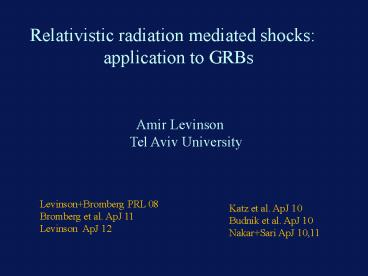Amir Levinson - PowerPoint PPT Presentation
Title:
Amir Levinson
Description:
Title: No Slide Title Author: Amir Levinson Last modified by: Admin amir Created Date: 8/26/2002 1:03:38 PM Document presentation format: Pr sentation l' cran (4:3) – PowerPoint PPT presentation
Number of Views:52
Avg rating:3.0/5.0
Title: Amir Levinson
1
Relativistic radiation mediated shocks
application to GRBs
Amir Levinson Tel Aviv University
LevinsonBromberg PRL 08 Bromberg et al. ApJ
11 Levinson ApJ 12
Katz et al. ApJ 10 Budnik et al. ApJ
10 NakarSari ApJ 10,11
2
Motivation
- In GRBs a considerable fraction of the outflow
bulk energy may dissipate beneath the
photosphere. - - dissipation mechanism shocks? magnetic
reconnection ? other ? In this talk I consider
sub-photospheric shocks - Strong shocks that form in regions where the
Thomson depth exceeds unity are expected to be
radiation dominated. - - Structure and spectrum of such shocks are
vastly different than those of collisionless
shocks.
Other examples shock breakout in SNs, LLGRB,
etc accretion flows
3
Photospheric emission
GRB090902B
4
Collapsar simulations
Lazzati et al. 2009
Substantial fraction of bulk energy dissipates
bellow the photosphere via collimation shocks
5
A model with magnetic dissipation
Magnetic jets may be converted to HD jets above
the collimation zone
Levinson Begelman 13
6
Internal shocks
Bromberg et al. 2011
Sub-photospheric shocks
Morsony et al. 2010
t
collisionless shocks
G
7
What is a Radiation Mediated Shock?
Shock mechanism involves generation and
scattering of photons
- downstream energy dominated by radiation
- upstream plasma approaching the shock is
decelerated by scattering of counter streaming
photons
8
Under which conditions a RMS forms ?
Radiation dominance downstream aTd4 gt nd
kTd From jump conditions numpc2?u2 ? aTd4
?
?u gt 410-5 (nu /1015 cm-3)1/6
In addition, photon trapping requires
Diffusion time tD shock crossing time tsh ?
? gt 1/?u
9
RMS versus RRMS
- Non-relativistic RMS
- small energy gain De/eltlt1
- diffusion approximation holds. Used in most
early treatments - Zeldovich Raiser 1967 Weaver 1976 Blandford
Pyne 1981 - Lyubarsky Sunyaev 1982 Riffert 1988
- Relativistic RMS
- photon distribution is anisotropic
- energy gain large De/e gt1
- optical depth depends on angle t a (1-b cosq)
- copious pair production
- Levinson Bromberg 08 Katz et al. 10 Budnik et
al. 10 Nakar Sari 10,11 Levinson 12
10
Photon source two regimes
- Photon production inside the shock (dominant in
shock breakouts from stellar envelopes, e.g., SN,
LLGRBs..) - Photon advection by upstream fluid (dominant in
GRBs Bromberg et al 11)
11
Velocity profile for photon rich upstream
Levinson Bromberg 2008
12
Solutions cold upstream (eg., shock breakout in
SN)
Velocity profile
13
Collisionless shocks versus RMS
- Scale c/?p 1(n15)-1/2 cm , c/?B 3?(B6)-1 cm
- can accelerate particles to non-thermal
energies.
collisionless
Plasma turbulence
- scale (?T n ?s)-1 109 n15-1 cm
- microphysics is fully understood
- cannot accelerate particles
RMS
14
Detailed structure
- Shock transition fluid decelerates to terminal
DS velocity - Immediate DS radiation roughly isotropic but
not in full equilibrium - Far DS thermodynamic equilibrium is established
shock transition
- Very hard spectrum inside shock
- Thermal emission with local temp. downstream
15
Thermalization depth
Photon generation Bremst. double Compton
Free-free t'ff 105?ff-1 (nu15)-1/8?u3/4
Double Compton t'DC 106 ?DC-1 (nu15)-1/2?u-1
Thermalization length gtgt shock width
16
Temperature profile behind a planar shock (no
adiabatic cooling)
Thermalization by free-free double Compton
Levinson 2012
17
Spectrum inside the shock (cold upstream)
- Temperature in immediate downstream is regulated
by pair production - Ts is much lower in shocks with photon rich
upstream (as in GRBs)
18
Prompt phase in GRBs shock in a
relativistically expanding outflow
?s/rph (r/ rph )2?-2
19
Breakout and emission
- shock emerges from the photosphere and
eventually becomes collisionless - shells of shocked plasma that reach the
photosphere start emitting - time integrated spectrum depends on temperature
profile behind the shock - at the highest energies contribution from shock
transition layer might be significant
photosphere
20
Upstream conditions
Example adiabatic flow
21
Computation of single shock emission
Integrate the transfer eq. for each shocked shell
to obtain its photospheric temperature
rph
rs
r0
Ts
Tph(rs)
22
Time integrated SED a single relativistic shock
Contribution from the shock transition layer is
not shown
Uniform dissipation
?u2
?u10
?u5
?u const
?010 R6102
0.01
10
0.1
1
From Levinson 2012
23
Dependence on dissipation profile
?u10, ?0100
?u10(?/?0)1/2
1
10
0.1
0.01
24
Mildly relativistic shocks
Uniform dissipation (?uconst)
0.1
0.01
0.001
25
Dependence on optical depth
Uniform dissipation
0.1
1
0.01
26
Multipole shock emission
- Single shock emission produces thermal spectrum
below the peak. - Multiple shock emission can mimic a Band spectrum
27
Several shocks with different velocities
Keren Levinson, in preparation
nEn a n1.4
Preliminary results
10-3
28
Sum of 4 shocks (uniform velocity, equal spacing)
Keren Levinson in preparation
nEn a n1.2
Preliminary results
29
Non-equal spacing
30
post breakout
photosphere
- Shock becomes collisionless
- particle acceleration
- nonthermal emission from accelerated particles
- possible scattering of photospheric photons by
nonthermal pairs
To be addressed in future work
31
Conclusions
- Relativistic radiation mediated shocks are
expected to form in regions where the Thomson
optical depth exceeds unity. - Time integrated SED emitted behind a single
shock has a prominent thermal peak. The location
of the peak depends mainly on upstream conditions
and the velocity profile of the shock. - The photon spectrum inside the shock has a hard,
nonthermal tail extending up to the NK limit, as
measured in the shock frame. Doesnt require
particle acceleration! - Multiple shock emission can mimic a Band
spectrum































